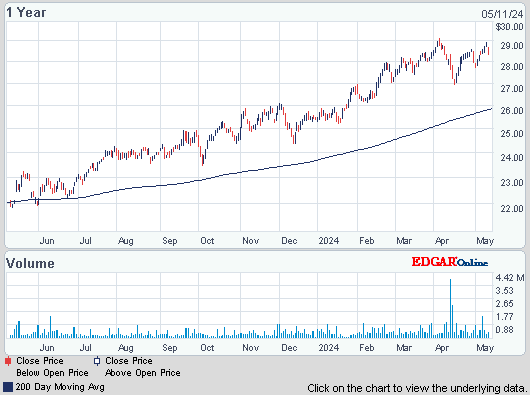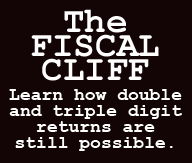Dow leaped 87 to another record (closing at the highs), advancers ahead of decliners 5-2 & NAZ edged up 3. The MLP index inched up pocket change in the 451s (flattish since late Mar) & the REIT index continued rising, up 1+ to the 307s (another high since late 2007). Junk bond funds edged higher & Treasuries were mixed. Oil fell back despite rising tensions in the MidEast & gold also retreated, to the mid 1400s.
AMJ (Alerian MLP Index tracking fund)

![Live 24 hours gold chart [Kitco Inc.]](http://www.kitco.com/images/live/gold.gif)


Photo: Bloomberg
Federally funded benefits paid to the long-term unemployed were lowered 10.7% starting Mar 31 as part of reductions to planned gov spending. Benefit cuts will affect about 1.8M workers, based on Labor Dept data & add to the drag on consumer spending from a payroll tax increase that took effect in Jan. The reductions will shave about $2.4B from the unemployment trust fund this fiscal year, according to the OMB. While that’s not enough to have a measurable impact on $11T in annual consumer spending nationwide, the effect will be magnified in places with large numbers of long-term unemployed & in states with generous programs, such as Hawaii. States with the most at stake include Alaska, California, Connecticut, Michigan & New Jersey, with 2% or more of their labor forces on long-term benefit. Those 5 states accounted for $2.75T in GDP in 2011, (21% of the US total). Pennsylvania, with 1.8% of its workforce receiving extended benefits, has already started sending smaller checks. Administrative issues are stalling implementation of the cuts in most other states. Consumers are also feeling the pinch of a higher payroll tax rate after the levy that funds Social Security reverted in Jan to 6.2% from 4.2%. For households earning $50K a year, that translates to about $80 less a month in disposable income.
Unemployment Benefit Cut Adds to Drag on U.S. Spending: Economy
Americans cut back on using credit cards in Mar, suggesting many were reluctant to take on high-interest debt to make purchases. The Federal Reserve says consumer borrowing rose just $8B in Mar from Feb to $2.8T, the smallest increase in 8 months. The gain was driven entirely by more loans to attend school & buy cars. The category that measures those loans increased $9.7B. A measure of credit card debt fell $1.7B & remains 17.2% below its peak set in Jun 2008! Since the recession, consumers have been more cautious about using credit cards. Expectations are that consumers will stay cautious this year, in part because of an increase in Social Security taxes that has reduced tax-home pay for most Americans.
US consumers cut back on credit card use in March AP

Photo: Bloomberg
YouTube from Google will offer paid subscription channels over the next few weeks, expanding the choices for television viewers beyond traditional pay-TV packages. Each channel will cost about $1.99 a month, with some variety in price. The platform will help programming partners generate revenue beyond advertising & one-time rentals of movies & TV shows, YouTube said. “We’re looking into creating a subscription platform that could bring even more great content to YouTube,” the company wrote. With paid YouTube channels, GOOG would join offerings of an online alternatives to traditional pay TV. Fees could provide YouTube & its suppliers with a supplement to advertising revenue to help pay for more expensive productions, & broaden options for viewers outside of cable or satellite services. Estimates say YouTube will generate $3.6B in revenue this year. GOOG lost $5 on the news.
YouTube Said to Plan $1.99 Subscription Channels in Coming Weeks

AMJ (Alerian MLP Index tracking fund)
Treasury yields:
U.S. 3-month |
0.033% | |
U.S. 2-year |
0.214% | |
U.S. 10-year |
1.760% |
| CLM13.NYM | ....Crude Oil Jun 13 | ....95.61 | (0.6%) |
![Live 24 hours gold chart [Kitco Inc.]](http://www.kitco.com/images/live/gold.gif)


Photo: Bloomberg
Federally funded benefits paid to the long-term unemployed were lowered 10.7% starting Mar 31 as part of reductions to planned gov spending. Benefit cuts will affect about 1.8M workers, based on Labor Dept data & add to the drag on consumer spending from a payroll tax increase that took effect in Jan. The reductions will shave about $2.4B from the unemployment trust fund this fiscal year, according to the OMB. While that’s not enough to have a measurable impact on $11T in annual consumer spending nationwide, the effect will be magnified in places with large numbers of long-term unemployed & in states with generous programs, such as Hawaii. States with the most at stake include Alaska, California, Connecticut, Michigan & New Jersey, with 2% or more of their labor forces on long-term benefit. Those 5 states accounted for $2.75T in GDP in 2011, (21% of the US total). Pennsylvania, with 1.8% of its workforce receiving extended benefits, has already started sending smaller checks. Administrative issues are stalling implementation of the cuts in most other states. Consumers are also feeling the pinch of a higher payroll tax rate after the levy that funds Social Security reverted in Jan to 6.2% from 4.2%. For households earning $50K a year, that translates to about $80 less a month in disposable income.
Unemployment Benefit Cut Adds to Drag on U.S. Spending: Economy
Americans cut back on using credit cards in Mar, suggesting many were reluctant to take on high-interest debt to make purchases. The Federal Reserve says consumer borrowing rose just $8B in Mar from Feb to $2.8T, the smallest increase in 8 months. The gain was driven entirely by more loans to attend school & buy cars. The category that measures those loans increased $9.7B. A measure of credit card debt fell $1.7B & remains 17.2% below its peak set in Jun 2008! Since the recession, consumers have been more cautious about using credit cards. Expectations are that consumers will stay cautious this year, in part because of an increase in Social Security taxes that has reduced tax-home pay for most Americans.
US consumers cut back on credit card use in March AP

Photo: Bloomberg
YouTube from Google will offer paid subscription channels over the next few weeks, expanding the choices for television viewers beyond traditional pay-TV packages. Each channel will cost about $1.99 a month, with some variety in price. The platform will help programming partners generate revenue beyond advertising & one-time rentals of movies & TV shows, YouTube said. “We’re looking into creating a subscription platform that could bring even more great content to YouTube,” the company wrote. With paid YouTube channels, GOOG would join offerings of an online alternatives to traditional pay TV. Fees could provide YouTube & its suppliers with a supplement to advertising revenue to help pay for more expensive productions, & broaden options for viewers outside of cable or satellite services. Estimates say YouTube will generate $3.6B in revenue this year. GOOG lost $5 on the news.
YouTube Said to Plan $1.99 Subscription Channels in Coming Weeks
Google (GOOG)
Caterpillar (CAT) & JPMorgan (JPM) were the 2 biggest winners in the Dow with gains of 2%+ while only 6 fell. The 2 biggest losers were Cisco (CSCO) down more than 2% & Microsoft (MSFT) off more than 1%. There was little in the economic background to drive today's rally, just a lack of will by the bears. The US economy is wishy-washy, growing but at subdued rate which is what it has been doing since the recession lows in mid 2009. Unsatisfactory growth has been getting rave reviews by stock buyers who are afraid of being left behind. Dow has risen a startling 3K since its low last Jun 4, one of the greatest rises in history. My portfolio has done well, but unsure how long this euphoria can last with a drab economic recovery.
Dow Jones Industrials









No comments:
Post a Comment